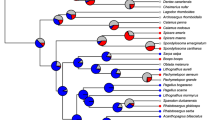Synopsis
The evolutionary stability of simultaneous hermaphroditism depends in part on the existence of constraints on the potential for male mating success. In the seabasses (Serranidae), several species of simultaneous hermaphrodites divide each day's clutch of eggs into parcels that are spawned sequentially and alternately with a partner. This behavior is thought to be one source of constraint on male mating success. A possible related source is the pattern of egg production. A study was therefore performed on the chalk bass,Serranus tortugarum, to examine this pattern. The results indicate that eggs are readied for spawning gradually over the course of the daily spawning period. The pattern of egg production acts jointly with spawning behavior in constraining male mating success. This pattern may be a pre-existing state to which the mating system has been adjusted, or it may have co-evolved with the mating system.
Similar content being viewed by others
References cited
Barlow, G.W. 1984. Patterns of monogamy among teleost fishes. Arch. Fischereiwiss. 35: 75–123.
Charnov, E.L. 1979. Simultaneous hermaphroditism and sexual selection. Proc. Natl. Acad. Sci. USA 76: 2480–2484.
Charnov, E.L. 1982. The theory of sex allocation. Princeton University Press, Princeton. 355 pp.
Emlen, S.T. & L.W. Oring. 1977. Ecology, sexual selection, and the evolution of mating systems. Science 197: 215–233.
Fischer, E.A. 1980. The relationship between mating system and simultaneous hermaphroditism in the coral reef fish,Hypoplectrus nigricans (Serranidae). Anim. Behav. 28: 620–633.
Fischer, E.A. 1981. Sexual allocation in a simultaneously hermaphroditic coral reef fish. Amer. Natur. 117: 64–82.
Fischer, E.A. 1984. Egg trading in the chalk bass,Serranus tortugarum, a simultaneous hermaphrodite. Z. Tierpsychol. 66: 143–151.
Fischer, E.A. 1986. Mating systems of simultaneously hermaphroditic serranid fishes. pp. 776–784. In: T. Uyeno, R. Arai, T. Taniuchi, and K. Matsuura (ed.) Indo-Pacific Fish Biology: Proceedings of the Second Conference on Indo-Pacific Fishes, Ichthyological Society of Japan, Tokyo.
Fischer, E.A. 1987. Mating behavior in the black hamlet — gamete trading or egg trading? Env. Biol. Fish. 18: 143–148.
Fischer, E.A. & C.W. Petersen. 1987. The evolution of sexual patterns in the seabasses. Bioscience 37: 482–489.
Ghiselin, M.T. 1969. The evolution of hermaphroditism among animals. Q. Rev. Biol. 44: 189–208.
Ghiselin, M.T. 1974. The economy of nature and the evolution of sex. University of California Press, Berkeley. 346 pp.
Gronell, A.M. 1984. Courtship, spawning and social organization of the pipefish,Corythoichthys intestinalis (Pisces: Syngnathidae) with notes on two congeneric species. Z. Tierpsychol. 65: 1–24.
Gwynne, D.T. 1981. Sexual difference theory: Mormon crickets show role reversal in mate choice. Science 213: 779–780.
Hastings, P.A. & C.W. Petersen. 1986. A novel sexual reproductive pattern in serranid fishes: simultaneous hermaphrodites and secondary males inSerranus fasciatus. Env. Biol. Fish. 15: 59–68.
Knowlton, N. 1979. Reproductive synchrony, parental investment, and the evolutionary dynamics of sexual selection. Anim. Behav. 27: 1022–1033.
Leigh, E.G. Jr., E.L. Charnov & R.R. Warner. 1976. Sex ratio, sex change, and natural selection. Proc. Natl. Acad. Sci. USA 73: 3655–3660.
Nakatsuru, K. & D.L. Kramer. 1982. Is sperm cheap? Limited male fertility and female choice in the lemon tetra (Pisces, Characidae). Science 216: 753–755.
Odendaal, F.J., Y. Iwasa & P.R. Ehrlich. 1985. Duration of female availability and its effect on butterfly mating systems. Amer. Natur. 125: 673–678.
Petersen, C.W. & E.A. Fischer. 1986. Mating system of the hermaphroditic coral-reef fish,Serranus baldwini. Behav. Ecol. Sociobiol. 19: 171–178.
Pressley, P.H. 1981. Pair formation and joint territoriality in a simultaneous hermaphrodite — the coral-reef fishSerranus tigrinus. Z. Tierpsychol. 56: 33–45.
J.R. Randall (1968) Caribbean reef fishes T.H.F. Publications Neptune City
Randall, J.R. 1968. Caribbean reef fishes. T.H.F. Publications, Neptune City. 318 pp Smith, C.L. 1965. The patterns of sexuality and the classification of serranid fishes. Am. Mus. Novit. 220: 1–20.
Smith, R.L. 1976a. Brooding behavior of a male water bug,Belostoma flumineum (Hemiptera: Belostomatidae). J. Kans. Entomol. Soc. 49: 333–343.
Smith, R.L. 1976b. Male brooding behavior of the water bugAbedus herberti (Hemiptera: Belostomatidae). Ann. Entomol. Soc. Amer. 69: 740–747.
Stacey, N.E. 1981. Hormonal regulation of female reproductive behavior in fish. Amer. Zool. 21: 305–316.
Trivers, R.L. 1972. Parental investment and sexual selection. pp. 136–179. In: B. Campbell (ed.) Sexual Selection and the Descent of Man., 1871–1971, Aldine, Chicago.
Warner, R.R. 1984. Mating behavior and hermaphroditism in coral reef fishes. Amer. Sci. 72: 128–136.
Warner, R.R. & P. Lejeune. 1985. Sex change limited by paternal care: a test using four Mediterranean labrid fishes, genus Symphodus. Mar. Biol. 87: 89–99.
Warner, R.R., D.R. Robertson & E.G. Leigh Jr. 1975. Sex change and sexual selection. Science 190: 633–638.
Williams, G.C. 1975. Sex and evolution. Princeton University Press, Princeton. 201.
Wittenberger, J.F. & R.L. Tilson. 1980. The evolution of monogamy: hypotheses and evidence. Ann. Rev. Ecol. Syst. 11: 197–232.
Author information
Authors and Affiliations
Rights and permissions
About this article
Cite this article
Fischer, E.A., Hardison, P.D. The timing of spawning and egg production as constraints on male mating success in a simultaneously hermaphroditic fish. Environ Biol Fish 20, 301–310 (1987). https://doi.org/10.1007/BF00005301
Received:
Accepted:
Issue Date:
DOI: https://doi.org/10.1007/BF00005301




